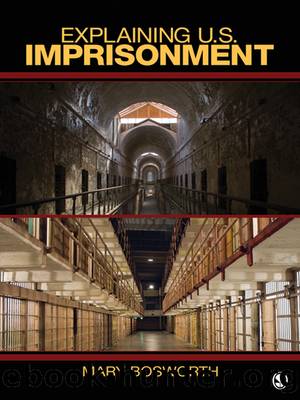Explaining U.S. Imprisonment by Mary F. Bosworth

Author:Mary F. Bosworth [Bosworth, Mary F.]
Language: eng
Format: epub
Tags: Social Science, Criminology, Penology
ISBN: 9781412924863
Google: Fvll4fVNx14C
Publisher: SAGE
Published: 2010-01-15T03:35:59+00:00
Prisons and Politics in the 1990s
Even as crime rates everywhere were falling, imprisonment rates continued to rise throughout the 1990s. Starting at 715,649 in 1990, the total population reached a massive 1,305,253 by 2000. In part due to the impact of the ever-growing base population, the rate of expansion of the confined population declined a little, from a staggering 43 percent increase between 1990 and 1995 to a still elevated 28 percent between 1995 and 2000 (Stephan, 1997; Stephan & Karberg, 2003). Not all states expanded their custodial systems equally, suggesting that no single factor can explain the rise throughout the country (Barker, 2006). It remains the case, however, that everywhere prison numbers grew (Greenberg & West, 2001; Jacobson, 2005).
Within the overall population, there was some variation. The tally of women behind bars expanded at a rate far higher than that of men, while more minority men were incarcerated than White men, and the population of Black and Hispanic women grew fastest of all. Reflecting changes in sentencing practices, more children were imprisoned than in previous periods as many states across the country lowered their maximum age of juvenile court jurisdiction to 15 or 16. By the end of the decade, all states had enacted legislation whereby juveniles charged with certain offenses were sent before adult courts. There, if found guilty, they would be sentenced to adult prison. While the average daily juvenile population in adult prisons in 1992 was 2,527 (representing an increase of 62 percent since 1983), by 1996 it had risen to 8,100 (U.S. Department of Justice, 2001; Strom, Smith, & Snyder, 1998). Finally, the numbers of confined noncitizens also increased substantially through the 1990s. In the federal system, noncitizens made up 25 percent of the total prison population (Stephan & Karberg, 2003).
Despite a continuing âboomâ in the prison building industry, construction (up 14 percent) did not keep pace with the increases in the incarcerated population anywhere other than in the private sector, which witnessed a 164 percent growth between 1995 and 2000. As a result, in most jurisdictions overcrowding simply became worse.
In sum, the 1990s, like the 1980s, was a decade characterized by a powerful punitive sentiment. That this mentality was fostered in a period dominated by a Democratic presidential administration challenged received wisdom on the connections between the Republican Party and punitiveness (Davey, 1998). As has been widely noted, Bill Clinton ran in 1992 on a tough-on-crime initiative, cynically taking time out from his campaigning schedule to return to Arkansas to sign the execution warrant of Ricky Ray Rector, a man with diminished mental capacity. Once elected, Clinton continued to use his âhands-onâ experience in punishment as political capital, stating proudly to the members of the law enforcement community at the Ohio Peace Officers Training Academy on February 15, 1994, âI know what it means to double the prison capacity of a state, and to sign laws toughening crimes, and to carry out the death penalty, to add to the stock of police officers and try to deal with all the problems that are facing themâ (Clinton, 1994b).
Download
This site does not store any files on its server. We only index and link to content provided by other sites. Please contact the content providers to delete copyright contents if any and email us, we'll remove relevant links or contents immediately.
The 1921 Tulsa Race Massacre by Chris M. Messer(284)
Introduction to Criminal Justice - A Balanced Approach by Brian K. Payne Willard M. Oliver Nancy E. Marion(253)
Russia's Sakhalin Penal Colony, 1849â1917 by Andrew A. Gentes(247)
Punishing the Poor The Neoliberal Government of Social Insecurity by Unknown(246)
The History of Newgate Prison by Jowett Caroline;(235)
Serial Killers America and UK - 2 BOOKS IN 1 by Clark Matthew(209)
A History of Police and Masculinities, 1700-2010 by David G. Barrie Susan Broomhall(195)
Restorative Justice in Transitional Settings by Kerry Clamp(168)
Organized Crime and Corruption Across Borders by T. Wing Lo Dina Siegel Sharon I Kwok(158)
Culture, Crime and Punishment by Ronald Kramer(155)
Cops, Cameras, and Crisis by Michael D. White Aili Malm(153)
Dangerousness, Risk and the Governance of Serious Sexual and Violent Offenders by Karen Harrison(152)
Policing Gender, Class And Family In Britain, 1800-1945 by Linda Mahood(151)
Routledge Handbook on Immigration and Crime by Holly Ventura Miller Anthony Peguero(150)
The Real CSI by Kate Bendelow(149)
Women Exiting Prison by Bree Carlton Marie Segrave(140)
Losing Legitimacy by Gary Lafree(138)
Using Murder by Philip Jenkins(135)
A Theory of African American Offending by James D. Unnever Shaun L. Gabbidon(134)
